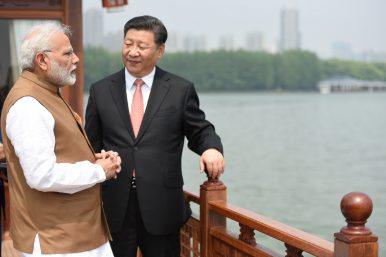By Merriden Varrall and Charlie Lyons Jones
 Many have written on the recent meeting in Wuhan between Chinese President Xi Jinping and Indian President Narendra Modi. However, these articles tend to focus on either the agenda for the meeting, what it did or didn’t achieve, or what to make of it in terms of geostrategic gains or losses. Few, if any, articles have looked at China’s perspective on the meeting. This is an important oversight as how the visit was described in the Chinese media reveals a great deal about how China sees its relationship with India.
Many have written on the recent meeting in Wuhan between Chinese President Xi Jinping and Indian President Narendra Modi. However, these articles tend to focus on either the agenda for the meeting, what it did or didn’t achieve, or what to make of it in terms of geostrategic gains or losses. Few, if any, articles have looked at China’s perspective on the meeting. This is an important oversight as how the visit was described in the Chinese media reveals a great deal about how China sees its relationship with India.
There has been a buzz around the meeting in the English language media, including in India. Some articles are nothing short of triumphant, describing an “incredibly significant” event that heralds a “new starting point” for bilateral relations between the two countries. Others saw it as a moment of weakness for India, where India “blinked” under Chinese pressure.
The Chinese state media, however, did not give anywhere near as much attention to the summit as their English language counterparts. Indeed, in one press conference that was supposed to be on Sino-Indian relations, the Chinese speaker spent most of the time talking about Taiwan. When the spokesman for the Ministry of National Defense took the podium at a press conference on April 26, the day after the meeting, rather than discussing Sino-Indian relations, most of his comments were devoted to recent military drills in Taiwan. In fact, the only thing said about Sino-Indian ties was remarkably bland in comparison to what was flying around in the international press. The spokesman said, “China and India are inescapable neighbors, [so] stable relations between the two countries while safeguarding the border regions and peace” is a top priority for both countries. It was almost as if the meeting hadn’t happened. Warm Sino-Indian relations were seen as a mere practical necessity.
Where the bilateral meeting that so captured the imagination of India and the West did get a mention in Chinese-language media, it was not lead story news. Articles on the ongoing relevance of Marxism in China took up more space. In the April 25 edition of the People’s Daily, the headline article had the catchy title of “Deepening the realization and mastery of the powerful truth in Marxism when composing the new chapter for the new era of socialism with Chinese characteristics.” This article took up nearly a quarter of the front page, while Modi’s “informal” meeting with Xi was allotted only a small section in the corner. When China’s ambassador to India Luo Zhaohui penned an article in favor of rapprochement with India, the People’s Daily editorial team relegated it to page three. It featured alongside other international news on Russia, the United Nations, and the Shanghai Cooperation Organization.
Where the story did get some traction in China, the emphasis was on China’s superiority over a weaker and supplicant India. In another article in the People’s Daily after the event, Xi was portrayed as the visionary statesman. According to that newspaper, Modi’s first response to Xi’s vision was to thank him for the cordial invitation to visit.
Interestingly, China’s English-language media took an approach much more in line with the broader English-language coverage. For example, the Xinhua News Agency’s English headline was “Xi-Modi gathering to guide China-India cooperation” and looked at how the two countries were working together to “exchange views over long-term and strategic issues and to initiate fresh momentum for future bilateral cooperation.” The Global Times’ English headline was “An incremental approach to addressing long-term Sino-Indian issues” and described India as being an “Asian giant” like China.
A reading of the Chinese language media demonstrates a common dilemma — just how wide the gap is between the messaging for China’s domestic population, and the image China wants to communicate to the world. At home, Sino-Indian relations are being given a very low profile. In Chinese language coverage, the Xi-Modi meeting was portrayed as a low-key, necessary means by which to “reset relations.” It is acknowledged that there are some unsatisfactory aspects to the relationship, but they are largely insignificant, and well within the Party-state’s ability to manage.
The message to the international community, however, was very much in keeping with Xi’s “responsible great power” persona we have been seeing of late, such as at Davos and the recent Bo’ao Forum.
Given that most English-language analysis of the Xi-Modi meeting did not take account of Chinese-language coverage of the event, it is not surprising that the broad conclusion has been that there was genuine Sino-Indian rapprochement. However, for China, the whole thing seems to have been little more than a just a drop in the ocean.
Dr. Merriden Varrall is Director of the East Asia Program at the Lowy Institute
Charlie Lyons Jones is an intern at the Lowy Institute’s East Asia Program.
No comments:
Post a Comment